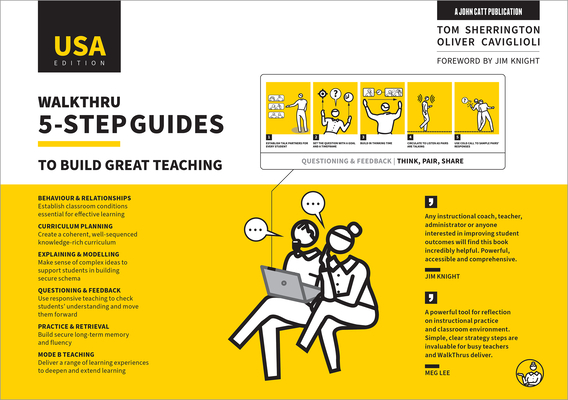
Teachers who want to rely on cognitive science to improve our teaching have SO MANY good options to choose from:
The best ways to help students practice,
The best ways to help explain new material,
Even the best ways to help students feel connected to one another.
This good news, however, can quickly become bad news.
How can we keep track of all this guidance?
How can we balance and combine all these suggestions?
As I’ve written elsewhere, we’re lucky to have an increasing number of books that bring all these pieces together. (I wrote about Teaching and Learning Illustrated just a few weeks ago.)
Another EXCELLENT candidate in this field has been published for a US audience in recent months: Walkthru: 5-Step Guides to Build Great Teaching by Tom Sherrington and Oliver Caviglioli.
Many books in this field summarize and organize research into coherent topics and flow charts.
Sherrington and Caviglioli – long time educators, both – take a different approach. They start from the assumption that teachers want to do something practical with the research right now.
With that in mind, they sort dozens of ideas into “Walkthrus”: a series of five concrete steps that teachers can take to focus on and improve a particular part of their teaching practice.
You want to be better at cold calling?
You want a new way to think about seating charts?
Maybe you’d like to create routines that foster a sense of classroom belonging?
For each of these goals – and DOZENS of others — you can pick a Walkthru and get down to work.
Here’s the fuller story:
The Background
Sherrington and Caviglioli build their Walkthrus on conceptual work done by many other scholars in this field. And – helpfully – they highlight these conceptual frameworks in the first section of their book, entitled “Why?”
MANY – perhaps most – of these frameworks will be familiar to long-time readers.
You’ve already heard about Caviglioli’s own work on dual coding.
I interviewed Blake Harvard for this blog many years ago.
Peps Mccrea’s book on Motivation gets the focus it deserves.
All the greats appear in this first section: Dan Willingham, and Generative Learning, and Shimamura’s MARGE model, and Cognitive Load Theory, and …
In effect, these 30 pages briskly summarize the essential thinkers, models, and frameworks of recent decades.
You might think this “Why” section as a Hall of Fame for this field.
Getting Practical
This sort of brisk summary can be inspiring, but it can also be overwhelming. What should we teachers DO with SO MUCH information?
Fear not!
Sherrington and Caviglioli spend the next 200+ pages answering exactly that question.
As a teacher – or instructional leader – you might pick one of the book’s broader sections: say, “Questioning and Feedback,” or “Behavior and Relationships,” or “Mode B Teaching.”
Or, you might pick one of the individual Walkthrus.
To take one example – literally at random – you might decide to work on helping students read. Happily, one Walthru focuses on “Building a Culture of Reading.” Steps here include:
Read Across the Curriculum, and
Embrace Reading Aloud, and
Embed Reading in Homework Tasks.
You can work through these steps at your own pace in an iterative cycle, which Sherrington and Caviglioli call “ADAPT” (see page 290).
In other words: teachers don’t need to do everything all at once. And we don’t need to figure out how to structure the application process.
Instead, Walkthrus walks us through the translation from theory (the “Why” section) to practice (the “What” section).
This strategy means that an enormous amount of research-based advice is repackaged into brief and manageable steps.
Some Important Notes
First: The USA version of Walkthrus distills the greatest hits from a 3-volume version published in the UK. If you’re REALLY into Walkthrus, you might look for that larger set.
Second: Sherrington and Caviglioli – of course! – make decisions about what to include (and not). Not all teachers or leaders will agree with all these decisions.
However: you can easily find points of agreement and focus there. The book’s structure, in fact, encourages you to do so.
Third: I share a publisher (John Catt) with these authors; in fact, I wrote a “blurb” for the book. I don’t think these factors have influenced my review, but you should have those facts as you weigh my opinions.
TL;DR
You’re looking for a resource that sums up the most important ideas for applying cognitive science to the classroom?
You’d like it to be simultaneously comprehensive and manageable?
Walkthrus just might be the book for you.





